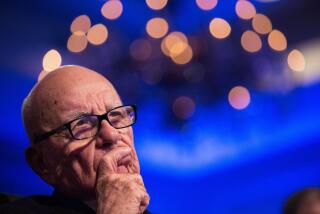News Web Sites’ Quandary: Using Ads Ethically
- Share via
As the news business struggles to keep pace with Internet time, much has been made of the World Wide Web’s ascendancy as a news medium. When the independent counsel’s long-awaited report on President Clinton’s relationship with Monica Lewinsky appeared on the Web first, the traditional media noted with envy and fear that the new medium was coming of age.
Some pundits predict the Internet will soon render the press as we know it obsolete. Even if that’s overstating the case, the Web is already crucial to news dissemination. So, not surprisingly, there’s been no shortage of hand-wringing about fast-and-loose news reporting on a medium in which half-truths, rumor, spam and subterfuge proliferate.
Of course, the mainstream press also suffers from plenty of credibility problems. But most major news organizations try to avoid actual or apparent conflicts of interest. And in light of their high-minded criticism of Web-only news sources, it seems fair to ask whether the top print and broadcast media manage Web ads in a way that will build the Web’s credibility as a news source.
As a standard for considering the question, here are some rules that most large newspapers and newsmagazines live by in print:
* No ads within the table of contents or news summaries, or above editorial content on any page.
* When ad copy appears similar to editorial content, mark the advertising clearly for what it is.
* Avoid placing ads that pertain to a particular article directly adjacent to that article.
It doesn’t take much surfing to determine that leading news publications--the sources normally expected to lead the rest of the media--hold themselves to a much lower standard of integrity on their Web sites.
Many of the sites use banner ads above or at the same level as the publication’s masthead, or within the table of contents or story summaries--unthinkable in the print world, but broadly considered a necessity to pull in advertisers online.
Some of the sites seem to portray advertising as editorial material. For example, Fortune magazine’s site listed ad links under the heading “Fortune Business Resources.” And click on the technology section of the MSNBC news site (a joint venture of Microsoft and NBC) and you’re sent directly to an unavoidable full-page ad for--surprise--Windows NT.
The most common problem was ad adjacency. In a spot check, I found Microsoft ads directly above or next to coverage of Microsoft news by the Web versions of the Wall Street Journal and the New York Times, and an IBM banner above an IBM story on CNN Interactive. (No such problems turned up on the Los Angeles Times Web site in a few hours of searching, though the site does not specifically block adjacency conflicts and has suffered from them in the past.)
“Dow Closes at Highest Level in 3 Months” was the headline on a recent article on USA Today’s site that was surrounded by two ads for investment services, plus ads for Microsoft Money (financial management software) and a credit-report service.
In USA Today’s book review section, reading and shopping become a seamless experience. In a click you can buy the book of your choice from within the prominent ad for Barnes & Noble’s online store beside every review.
What about Web-only news sources? Wired News and CNet’s News.com, two of the most popular technology news sites, ran Microsoft, Dell Computer and IBM banners over stories about those companies.
Standards of integrity in print developed over decades. “But almost no one in that great Web rush of ’97 and ’98 stopped to say, ‘Are the rules different?’ or ‘How do we make sure that we don’t confuse our readers?’ ” said Kenneth A. Paulson, executive director of the First Amendment Center at Vanderbilt University. “Things that would be talked to death in a newspaper meeting just happened overnight on the Web.”
Fortunately, the talk has begun. The American Society of Magazine Editors has developed guidelines that proscribe the sale of ad links embedded within editorial content or the skewing of a site’s search engine to favor advertisers.
But the guidelines don’t speak to ad-adjacency conflicts.
“We simply couldn’t address it because we didn’t know of any Web site in which adjacency was controllable,” said Phil Lemmons, editorial director of PC World magazine, who wrote the first draft of the guidelines and believes that adjacency conflicts undermine the credibility of news stories.
He explained that current Web advertising technologies display ad banners without regard to specific story content. That could be fixed, said Lemmons, but the problem may be more complex than it looks at a glance. “One virtue of the Web from the marketer’s point of view is that it allows more specific targeting than ever before. In essence, that’s an adjacency-driven model.”
But is that model invariably a problem? Sometimes it’s a convenience that consumers crave--for example, the ability to read a book review, then buy the book instantly.
One idea, Lemmons said, would be to let readers choose whether they want to see conflict-laden ad-edit adjacencies. “But if that’s offered everywhere, then it’s also likely to suggest that everything’s written to drive sales,” he said.
The Internet Content Coalition, an association of technology and media companies, is also working on guidelines for advertising.
“The Internet needs to have an ethical voice,” said Christopher Barr, editor in chief of CNet and the group’s co-chairman.
Let’s hope the Internet finds that voice soon. Because in a medium where the Drudge Report has been allowed to set a standard for immediacy, the almighty dollar seems to be setting the standard for conflicts of interest.
Innovation appears every other Monday in The Cutting Edge. Times staff writer Charles Piller can be reached via e-mail at charles.piller@latimes.com.






